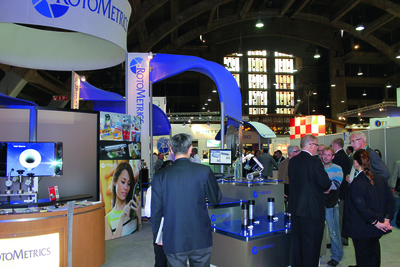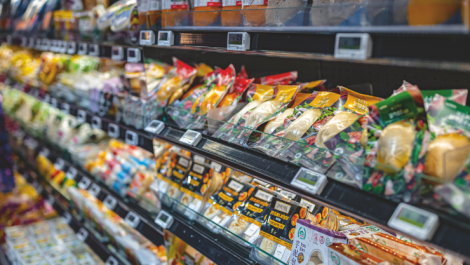RotoMetrics’ stand at Labelexpo
Increasingly intricate label shapes and thinner materials are demanding higher levels of sophistication from the die-cutting process. Labelexpo Europe saw a number of new launches and Neel Madsen caught up with a couple of suppliers.
Label shapes have to meet a wide range of decorating and marking needs, and the vast majority of narrow web flexo presses are configured with inline diecutting for single pass rollto- roll production. Diecutting pressure needs to be exact to ensure that the label will separate perfectly from the liner.
The release liner in effect functions as an ‘anvil’ against which the die applies the correct amount of pressure to cut through the printed material. In Europe, there is a general preference for flexible dies, ie sheets of steel mounted on a magnetic cylinder, while in the US, solid and flexible dies coexist happily each taking up about half the market share.
Lean range
At Labelexpo in Brussels, RotoMetrics launched its new Accu-Series range of flexible dies.
Ulrich Kretzschmar, product and business development manager for flexible dies, explained that after the acquisition of Gerhardt A/S, the company’s portfolio had become too wide with some products overlapping, and that there needed to be a refocusing of the flexible die catalogue.
After analysing the market to see what the exact requirements were, the company developed four key products for the Accu-Series. This new lean range covers all applications and offers customers an easy and clear choice, saving both time and money.
The AccuSmart die is the economical choice for short to medium runs ideal for standard liners. AccuPrime is a popular choice aimed at thinner liners down to around 30 microns, while AccuStar UltraFilm accommodates very tight plate tolerances for very thin liners down to 12 microns. The final product is the AccuStar Life developed for very long runs and abrasive materials and coatings.
Ryan Greis, director of global marketing, said, ‘This year, RotoMetrics used Labelexpo Europe to showcase the global launch of our new Accu-Series flexible die portfolio. Overwhelmingly, the crowds met our new portfolio with excitement because it meets a vast majority of needs within just four die products. As a result, RotoMetrics secured numerous orders and won several new customers, all around the this launch.
‘In the month after the show, our flexible die orders have jumped significantly.Many customers have shared their feedback that the new series outperforms competitor products. This is positive feedback and helps to validate our goal to provide worldclass support on an individual level.’
Staggered label solution
At the show, visitors could also see how bringing together the soft- and hardware expertise of Esko and Wink Stanzwerkzeuge create a highly efficient staggered label solution. This offers label converters the option to optimise label production, increase production speeds, enjoy material savings and produce highly accurate print and die-cutting results.
Wink is a leading supplier of diecutting tools, producing flexible dies, steel rule dies and rotary cylinders for label converters, envelope producers and other printing companies.
Headquarters are in Neuenhaus, in Germany, with subsidiaries in the Netherlands, Denmark, Italy and the USA, as well as sales agencies worldwide.
The partnership combines Wink’s die-cutting technology with Esko’s ‘staggered cut’ software and Kongsberg cutting tables, resulting in the ProShift technology, which enables impressions to be arranged more flexibly and make full use of the entire printing area. This is done using Wink’s laser technology to arrange the upper and lower edge of the flexible dies in steps. Esko’s sheet layout software Plato then creates the staggered label layout. This promises perfect alignment between the printing and cutting plate, as the data is exported simultaneously to create the staggered flexo plate and to order the shifted die at Wink.
‘This type of shifted printing and die-cutting has many advantages,’ explained Fransz Verbeek, product manager at Wink. ‘In most cases, labels are arranged symmetrically to save space and keep the consumption of materials to a minimum. However, this configuration is less beneficial for the rotary die-cutting process because vertical lines tend to cut more forcefully than horizontal lines and high contact pressure causes the vertical lines to cut even deeper. This can also damage the liner material and result in wear and lasting damage to all components in the cutting unit.’
ProShift counteracts these negative effects by vertically shifting the impressions in the machine’s running direction, which reduces the number of horizontal lines and evenly distributes cutting pressure.
The solution is particularly advantageous when cutting shapes with many horizontal lines: optimisation of die-cutting results and reduced liner damage, longer lasting flexible dies and machine parts, stabile waste stripping which prevents web breaks and thus reduces down time.






